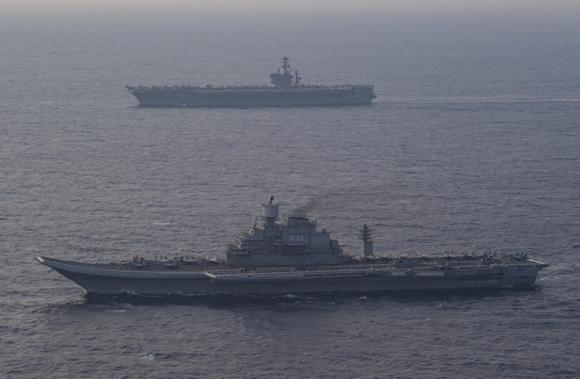"Never seen the waves surrender". Geopolitics is expressed in the confrontation of antitheses, between the domination of terrestrial spaces versus a flexible vision, frame of a universal and therefore unlimited vocation, based on connections and on the control of routes and obligatory passages: competition is and will still be among the foams.
The data confirms that maritime trade will continue to grow: the success of the new silk route it is bound to the conquest of the sea routes that surround the Rimland, certainly not to the Eurasian railways. The strategy that wants the Indo Pacific to be free and open confirms that the geopolitics of the XNUMXst century will be decided by the sea.
After 1989, the area was affected by the onset of unprecedented threats1, to which were added Iran and China, disturbing the pre-existing equilibrium. Now, the Sino-American rivalry obliges, in a regional context that perceives Chinese hegemony as a threat, to not easy alignments in accordance with two geopolitical concepts; the first redraws the borders according to a single arc of continuity, also taking into account the studies that for the next decades identify Asia-Pacific as the dominant factor in the global economy; the second outlines a geopolitics of protection, or the continuation of the economic war in a mature technological environment.
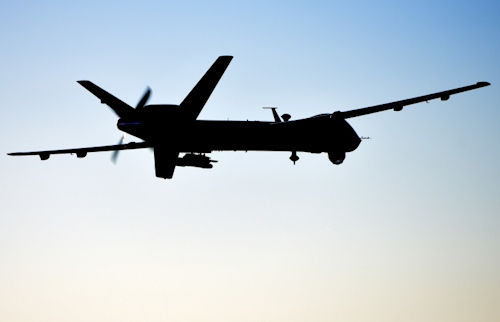 With a steadily increasing GDP, China has proposed itself as a valid economic counterpart to the countries of the area; military power and muscular displays have however led neighboring countries to strong concerns, encouraged by Chinese efforts aimed at confirming Beijing's affirmation as a regional center of gravity and global and alternative nerve center, with a network of alliances similar to the one that binds allies to USA, animated by both pivot to Asia by Kurt Campbell2, appointed by President Biden, and by the assumptions of theInterim National Security Strategic Guidance, which anticipated the National Security Strategy, to add The Elements of the China Challenge, which takes its cue from long telegram of 1946 by G. Kennan, and which examines ideological sources, Chinese vulnerabilities and American courses of action; in this sense, the change in the diplomatic paradigm for which the elective affinities with India, downgraded by Washington during the Cold War in favor of privileged relations with China and Pakistan as functional to the Soviet containment, now they are back in vogue with the rapprochement between the USA and New Delhi, threatened by Chinese assertiveness in the region and for which, according to the Times of India, Washington has promised to sell drones through General Atomics Predator.
With a steadily increasing GDP, China has proposed itself as a valid economic counterpart to the countries of the area; military power and muscular displays have however led neighboring countries to strong concerns, encouraged by Chinese efforts aimed at confirming Beijing's affirmation as a regional center of gravity and global and alternative nerve center, with a network of alliances similar to the one that binds allies to USA, animated by both pivot to Asia by Kurt Campbell2, appointed by President Biden, and by the assumptions of theInterim National Security Strategic Guidance, which anticipated the National Security Strategy, to add The Elements of the China Challenge, which takes its cue from long telegram of 1946 by G. Kennan, and which examines ideological sources, Chinese vulnerabilities and American courses of action; in this sense, the change in the diplomatic paradigm for which the elective affinities with India, downgraded by Washington during the Cold War in favor of privileged relations with China and Pakistan as functional to the Soviet containment, now they are back in vogue with the rapprochement between the USA and New Delhi, threatened by Chinese assertiveness in the region and for which, according to the Times of India, Washington has promised to sell drones through General Atomics Predator.
In summary, in the Indo Pacific the proscenium of both a regional multipolar order and an imperfect Sino-American bipolarity is becoming, both hypotheses unacceptable for the USA if they are harbingers of single influences. The general picture sees the Americans, previously self-excluded from the CPTPP and RCEP trade agreements3, now back to a rebalancing strategy between the large countries of the region, with an eye on turbulent Myanmar4.
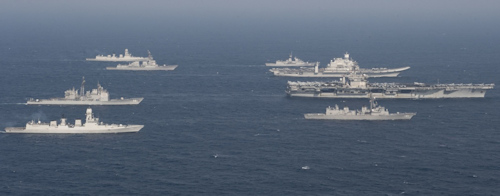
The Sino-American conflict raises the question of how relations will be managed, given that similar antagonisms, in the past, have led to war. From this perspective, the Fundamental defense agreements Indo-American, however, made difficult by the Indo-Russian ties and by the tenor of the responses to Chinese border provocations.
In a context characterized by an attempt at balance of power, the Chinese action is offset by India, Australia, Japan and the USA united in the Quad5, with Asean members6 frightened by the Dragon, in turn hit by the pandemic crisis that slowed international trade, and questioned both by the polarization induced by the friction with the USA, in a regional competition that cannot be framed in a zero-sum game, and by the tightening relations with Australia and India.
The triggers of a possible clash are many: the Koreas, with the North and its nuclear ambitions, the Senkaku islands disputed between Beijing and Tokyo, Taiwan, the Spratly and the Paracelsus, militarized by the Chinese despite the claims of the coastal countries, maritime expansion to the west. If the control of the South China Sea facilitates the Chinese thalassocratic rise, however tied to the American threat and the conquest of Taiwan, the USA, in not withdrawing from the principle of free navigation in an area secure and prosperous, and being able to bring in military forces thanks to the logistical support of the British Diego Garcia7, they have to deal with the close alliances between the actors of a region of rare breadth, an extension8 of over 65 million km2 rich in energy resources9 and surrounded by key passages10.
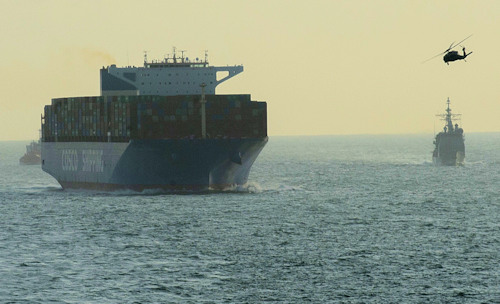 A second-rate area during the Cold War, more interested in Atlantic communication lines and those relating to flows to and from the Persian Gulf, but now a useful bridgehead to touch Africa, MO and to touch Europe, characterized by the presence of submarine cables11 necessary for the strengthening of the networks and the simultaneous increase of digital capacities, with commercial flows conditioned by a complex maritime geography, given that the routes useful for reaching the ports of mainland China plow the waters that either caress the coasts of the Indian subcontinent or touch the Strait of Malacca.
A second-rate area during the Cold War, more interested in Atlantic communication lines and those relating to flows to and from the Persian Gulf, but now a useful bridgehead to touch Africa, MO and to touch Europe, characterized by the presence of submarine cables11 necessary for the strengthening of the networks and the simultaneous increase of digital capacities, with commercial flows conditioned by a complex maritime geography, given that the routes useful for reaching the ports of mainland China plow the waters that either caress the coasts of the Indian subcontinent or touch the Strait of Malacca.
The pre-1989 dynamics have long placed the Indian Ocean on the margins of New Delhi's strategic interests, which has relegated its Navy to an ancillary role, given the importance given to Chinese and Pakistani continental threats; an inverted trend starting from the 90s, when the ocean was recognized as a primary role for national development which, now, could enjoy the decoupling American from China, which has, however, strengthened its underwater fleet. The need to defend its EEZ and maritime communication lines, which are involved in transporting 80% of energy needs from the OM, gives meaning to the alarm raised by the appearance of Beijing in the area, both as a result of the 1962 conflict.12, both for the recent clashes on the LAC13 and for the economic-infrastructural agreements signed at the regional level14, which motivate a sense of encirclement that can be limited by a policy of Neighborhood First; beyond his intentions, which aim at a control of the straits towards the east and on the islands15, New Delhi intends to oppose the Sino-Pakistani agreements, aimed at the creation of the economic corridor between Xinjiang and the port of Gwadar, in order to counteract the will of nuclear Islamabad, guarantor of a strategic foothold for Beijing.
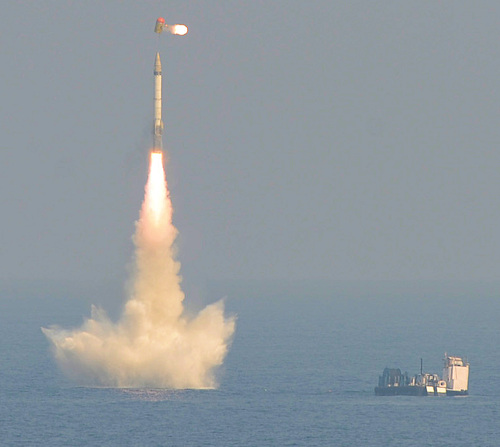 India, as an international power, while not having a valid national war industry, in becoming aware that interests cross borders, in pursuing the geopolitics of West look e East look, it intends to exercise both diplomatic action capable of garnering support and a projection of power backed by one Blue Navy like the one imagined by KM Panikkar, the Indian Mahan, who fueled the aspiration to one world-class Navy. In this respect, it should be noted the Indian nuclear submarine deterrence capacity which, although still in its infancy, includes its first boomers, the missile submarine Arihant, which will be followed byArighat, capable of launching up to four intermediate-range K-4 SLBMs or 12 K-15 missiles Sagarika (photo) short-range; a capacity incomplete because it is lacking in terms of boats, but which is a signal to the five permanent members of the UN Security Council; by the way this means that India, in the future, could enjoy a capacity of second strike, thanks to a nuclear triad16 able to discourage Pakistan and China, towards which further contention remains open for the construction of numerous dams intended to exploit the Brahmaputra, which crosses the disputed border between Delhi and Beijing and accentuates the rivalries over Tibet.
India, as an international power, while not having a valid national war industry, in becoming aware that interests cross borders, in pursuing the geopolitics of West look e East look, it intends to exercise both diplomatic action capable of garnering support and a projection of power backed by one Blue Navy like the one imagined by KM Panikkar, the Indian Mahan, who fueled the aspiration to one world-class Navy. In this respect, it should be noted the Indian nuclear submarine deterrence capacity which, although still in its infancy, includes its first boomers, the missile submarine Arihant, which will be followed byArighat, capable of launching up to four intermediate-range K-4 SLBMs or 12 K-15 missiles Sagarika (photo) short-range; a capacity incomplete because it is lacking in terms of boats, but which is a signal to the five permanent members of the UN Security Council; by the way this means that India, in the future, could enjoy a capacity of second strike, thanks to a nuclear triad16 able to discourage Pakistan and China, towards which further contention remains open for the construction of numerous dams intended to exploit the Brahmaputra, which crosses the disputed border between Delhi and Beijing and accentuates the rivalries over Tibet.
In addition to naval capabilities, there are tests on a series of newly developed systems, including a hypersonic cruise missile, a hybrid torpedo-missile (deployable against submarines and aircraft carriers), and an anti-radiation missile, useful for searching and destroying air defense systems equipped with radar. However, all the planned preparations, even those concerning aircraft carriers, logistic units and fighters, remain both under the risk of actual financial resources, and of an operation that, hit in 2014, forced the resignation, for the first time since 1947 , the Navy CSM, DK Joshi. The tormented liaison between India and Russia should not be underestimated, with a dated bond that saw the purchase of the S-400s. The divisions induced by the Sino-American crisis diminish the idea of the privileged strategic partnership desired by Moscow, so much so as to present Russia and India on different fronts, inspiring a policy that, obtended neck, would compromise the strategic autonomy of both, far removed from the Sino-Russian Indian trident imagined by Yevgeny Primakov.
 The Indo Pacifico does not admit limiting meanings, and strategically attracts multiple interests. The good relations between India and Israel, interested in strengthening its status in the area, could lead Tel Aviv to seek greater regional involvement, a dynamic that is affecting European countries such as Great Britain with its Global Britain in a competitive age; France, whose EEZ extends 93% into the Indian Ocean and the Pacific; Germany, "that he is rediscovering the ambition of power and will not go back, even if he does not know how far to go17", powers that have sent or intend to send military units to support missions Phonop18 conducted by the US Navy, which is joined by the Free and Open Indo Pacific Strategy Japanese and Canberra's new foreign policy lines19 involved in a trade war with China, all activities that led Beijing to denounce the attempt to establish an Asian NATO.
The Indo Pacifico does not admit limiting meanings, and strategically attracts multiple interests. The good relations between India and Israel, interested in strengthening its status in the area, could lead Tel Aviv to seek greater regional involvement, a dynamic that is affecting European countries such as Great Britain with its Global Britain in a competitive age; France, whose EEZ extends 93% into the Indian Ocean and the Pacific; Germany, "that he is rediscovering the ambition of power and will not go back, even if he does not know how far to go17", powers that have sent or intend to send military units to support missions Phonop18 conducted by the US Navy, which is joined by the Free and Open Indo Pacific Strategy Japanese and Canberra's new foreign policy lines19 involved in a trade war with China, all activities that led Beijing to denounce the attempt to establish an Asian NATO.
Note of color: the German guidelines for the Indo Pacific, inspired by K. Haushofer, were taken up in 2007 by the Japanese Abe and re-launched ten years later by Trump; to this must be added the interest aroused both in Five Eyes20, both last November from the National Security Law of Hong Kong, approved by China and severely limiting civil liberties, both as regards the management of the Huawei and 5G affair. And the war? According to Lincoln, the Americans must fear only themselves, while according to Flaiano trying to understand the Chinese is not only difficult, but even useless.
Secondo Asia Times, Beijing has acquired its superiority both thanks to the American relocation of sophisticated productions, both as a result of the economic choices that led to the global recession of 2008, and because of an innate Yankee lightness in long-term valuations, except for rare flashes of genius, such as Kissinger's who, in 2018, predicted to Edward Luce that China could overtake the US.

In China, especially after the Anchorage meeting that exposed the Chinese sensitive points, the topic is strongly followed and felt, on the wave of a nationalism that, inspired by the Korean War and an alleged lack of American fighting spirit , pushes to face the US in the South China Sea in order to both assert a sea power historically founded and politically legitimate regional, with an asymmetrical A2 / AD tactical-strategic structure capable of nullifying any US actions in a scenario characterized by military imbalance between the two sides, and of contending with India for control of the Indian Ocean; this without considering the reforms that have reshaped the Chinese FA, an actual lack of war experience, the lack of continuity of know-how innovative21, a faint soft power, a political rigidity capable of revealing the real features of a demagogy from balcony choir.
The challenge remains worrying, given the economic expansion and the projection of Chinese military power, given the outposts in Africa and Latin America, as well as military exercises with Russia. Robert Farley, of the National Interest, preceded by assessments that required capabilities such as to ensure the sinking of military and merchant units in the South China Sea within 72 hours of the start of the clashes, does not rule out the possibility of conflict even on two fronts, European against Moscow , and in the Indo Pacific against Beijing, availing itself of allied support in the Old Continent historical, and delegating to the Navy the most difficult operations in the Pacific, taking for granted the neutrality of the less gifted regional actors, and the support of India and Japan, destined for a naval competition with Beijing, in turn bound to a competitive coexistence with the USA. It is evident that the variables, even in the face of the containment political actions implemented, are really too many, in the face of a hegemonic spirit that is not placable.
1 Piracy, arms and drug trafficking
2 Indo-Pacific Coordinator within the National Security Council
3 Comprehensive and Progressive Agreement for Trans-Pacific Partnership; Regional Comprehensive Economic Partnership
4 In 1994 he granted China a base in the Coco Islands
5 Quadrilateral Security Dialogue; informal strategic agreement between the USA, Japan, Australia and India.
6 ASEAN (Association of South-East Asian Nations - Philippines, Indonesia, Malaysia, Singapore, Thailand, Brunei, Vietnam, Burma, Laos, Cambodia), is a political, economic organization of Southeast Asia. ASEAN regularly conducts dialogue meetings with other nations, which is coveted ASEAN dialogue partners: Australia, Canada, China, South Korea, USA, India, Japan, Mongolia, New Zealand, Russia, and the European Union.
7 44 km² atoll in the Indian Ocean 1600 km south of India. The island has been home to a US Navy base since 1971.
8 The Indian Ocean occupies approximately 20% of the surface of the globe with an area of 73.556.000 sq km.
9 Almost 40% of the world's offshore crude oil production comes from here
10 Cape of Good Hope and the Straits of Bab el-Mandeb, Hormuz, Malacca and Lombok
11 The longest fiber optic cable in the world (16.000 km), starting from Singapore will arrive in California, according to the project of the Trans-Pacific Networks supported by the International Development Finance Corporation, a US government agency born in 2019 to challenge the Silk Road.
12 The Sino-Indian War was a short but intense conflict between China and India in October 1962 for control of the northwestern part of the Aksai Chin and northeastern Indian territory. NEFA ("North East Frontier Agency"), delimited by the Johnson Line and the McMahon Line, both disputed by the Chinese side.
13 Line of Actual Control that separates the territory controlled by India from that controlled by China in the dispute over the Sino-Indian border
14 Myanmar, Pakistan, Sri Lanka, Djibouti
15 Strait of Malacca (Malaysia, Indonesia, Singapore); military infrastructure Andaman and Nicobar islands in the Bay of Bengal
16 Terrestrial, maritime, air
17 Lucio Caracciolo
18 Freedom of Navigation Operations
19 Australia collaborates with the United States Indo-Pacific Command (INDOPACOM)
20 Intelligence alliance between UK, Canada, New Zealand, Australia, USA
21 See Virginia-class attack submarines (SSN-774), anti-submarine missiles, Ford-class nuclear-powered aircraft carriers (CVN-78), ballistic missile defense systems and various classes of attack aircraft
Photo: US Navy / US Air Force / India MoD / MoD People's Republic of China

